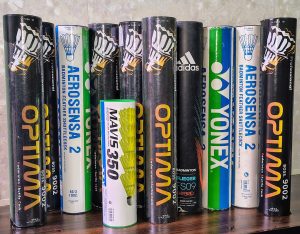The Feather Shuttlecock Crisis in Badminton: Causes, Effects, and the Road Ahead
Badminton is a sport of precision, speed, and agility—and nothing embodies these qualities better than the humble shuttlecock. Among the different types used, the feather shuttlecock holds a revered place, especially on the professional stage. But behind its delicate appearance lies a story of tradition, craftsmanship and in recent times, significant challenges. In this blog, we’ll take a deep dive into the history, specifications, differences between varieties, the ongoing shortage crisis, price hikes, and what industry experts say, all wrapped around the most popular shuttlecock brands today.
What’s Behind the Global Feather Shuttlecock Shortage?

A dramatic shortage of feather shuttlecocks has shaken the world of badminton. The crisis stems mostly from a reduced supply of duck and goose feathers, tied directly to changing food habits in China—where consumers now prefer pork over waterfowl, so fewer ducks and geese are raised. Other contributing factors include outbreaks of avian influenza, higher feed costs, and surging global demand. As a result, the supply of quality feathers for shuttlecock production has plummeted, affecting players from grassroots clubs to Olympic champions.
The History of the Feather Shuttlecock
The feather shuttlecock’s origins stretch back centuries. Ancient Chinese sports featured games using feather-tipped projectiles for skill and fun. Modern badminton, which formalized in British India during the 19th century, standardized the design: a rounded cork base with 16 feathers. By the 20th century, manufacturers were optimizing durability, flight, and quality, eventually establishing the feather shuttlecock as badminton’s icon worldwide
Feather vs. Nylon Shuttlecocks: Which Is Right for You?
Feather shuttles are preferred for matches and skillful play, while nylon is popular for recreational and practice sessions.
Duck vs. Goose Feather Shuttlecocks: Core Differences
- Goose Feathers: Thicker, stronger, and offer superior flight and durability; preferred in pro tournaments and higher priced
- Duck Feathers: Thinner and less resilient, resulting in a more fragile shuttle with moderate flight, best for recreational and training use
Thus, goose feather shuttlecocks are considered the premium standard while duck feather shuttles provide a more economical solution for less intense play.
Why Does BWF Require Feather Shuttlecocks for Tournaments?
The BWF mandates feather shuttles for top-level competition because:
- Flight Characteristics: Feather shuttles provide stable, predictable trajectories critical for skillful rallies
- Consistency: Strict specs assure fairness and high-level competition
- Tradition: Feather shuttles are deeply tied to the sport’s heritage
No synthetic or nylon shuttle has yet matched the flight dynamics and feel of the feathery original, keeping it as the gold standard of the game.
What are the BWF-Approved Specifications for Feather Shuttlecocks?
The Badminton World Federation (BWF) maintains strict specifications for feather shuttles used in tournaments:
- Feathers: 16 feathers, uniformly from a goose’s left wing, each 62–70 mm long
- Feather Placement: Feather tips must form a circle between 58–68 mm in diameter
- Base: Cork, 25–28 mm in diameter, rounded in shape
- Weight: Overall shuttlecock weight must be between 4.74 and 5.50 grams
- Flight: Stringent flight and stability standards, minimal wobbling, and variance
These regulations ensure consistency in shuttlecock flight and fairness in high-level play.
Most Popular Feather Shuttlecock Brands in the Badminton World
The badminton community overwhelmingly trusts these premium brands:
- Yonex: The leading global brand, official BWF/Olympics supplier
- Victor: Asia’s high-performance alternative
- Li-Ning: Chinese powerhouse gaining international ground
- RSL (Reinforced Shuttlecocks Limited): Known for quality and tradition
- Golden Eagle: Offers a balance between cost and quality
Yonex remains the gold standard for consistency, flight, and tournament approval.
2024-2025: The Year Feather Shuttlecock Prices Soared
In the last year:
- Retail prices for premium feather shuttlecocks have nearly doubled (e.g. from ₹1,200 to ₹2,700–3,000 per tube in India)
- Brands like Yonex hiked prices by 30–40% in China and globally
- Increasing costs traced back to scarcity of raw feathers, higher logistics expenses, and runaway demand
This trend has put financial pressure on clubs, academies, and everyday players.
Voices from the Badminton World: Coaches and Players on the Crisis
Leading figures have spoken candidly about the shuttlecock shortage:
Pullela Gopichand: Urges urgent exploration of synthetic and lab-grown shuttles while acknowledging the crisis’s impact on grassroots and elite levels.
Sanjay Mishra (BAI Secretary): Confirms the shortage is linked to changes in poultry farming and emphasizes the need for sustainable alternatives.
Franck Laurent (French Badminton Federation): Sees inevitable transition to hybrid shuttles but stresses current options don’t yet match feather performance.
Players and Coaches: Express frustration over soaring costs and supply shortages seriously affecting training budgets and club resources.
There’s a shared sense of urgency and hope for innovation to sustain the sport.
Conclusion: The Road Ahead
The feather shuttlecock shortage is testing the resilience of the badminton community worldwide. With price spikes biting deep and supplies increasingly stretched, innovation and adaptation—whether through new synthetic technologies or supply chain strategies—are essential. Yet, at the heart of it all, the feather shuttlecock’s heritage continues to symbolize the purity and challenge of badminton as a sport.
Stay connected with badmintonpb.com for the latest updates, expert opinions, and equipment reviews to keep your game flying high—no matter the challenges ahead!
Disclaimer:
This article is for informational purposes only. Some details are gathered from internet sources to help explain the real issue of feather shuttlecock shortages. Readers should verify information with official or primary sources for the most current and accurate updates.

